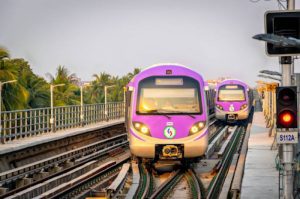Kolkata Bus Route Realignment: Kolkata, a city where buses and trams have historically carried the daily heartbeat of millions, is now witnessing a seismic shift in its transport dynamics. The West Bengal Transport Department has announced a comprehensive plan to realign bus routes across the city, ensuring that they complement the rapidly expanding metro network instead of competing with it.
The decision comes in response to the operationalization of the East-West Metro corridor connecting Howrah to Salt Lake Sector V, along with upcoming new stretches across North-South and airport-bound metro routes. These projects have started reshaping commuter behavior, with thousands choosing faster, underground alternatives over slower, congested surface roads.

Why the Realignment is Needed
For decades, buses were Kolkata’s backbone, carrying nearly half of its daily commuters. However, the metro’s expansion has fundamentally changed this balance.
- On routes parallel to the East-West Metro line, buses have reported daily losses of around ₹500–₹1,000 per vehicle, with passenger counts dropping by 50–100 per day. For operators already struggling with fuel prices and vehicle maintenance, this is a heavy blow.
- Some bus services, like S-12 (New Town–Howrah) and 215A (Salt Lake–Howrah), continue to thrive because they feed passengers into the metro rather than running directly parallel.
This pattern convinced policymakers that the future lies in integration, not competition. Instead of two systems cannibalizing each other, the goal is to create a seamless multimodal network, where buses extend the metro’s reach into residential pockets, marketplaces, and suburban areas.
The Transport Department’s Roadmap
Transport Minister Snehasis Chakraborty recently outlined the multi-pronged approach to modernize Kolkata’s bus operations.
1. Feeder Network Integration
Buses running parallel to metro tracks will be diverted to act as feeder services, ensuring passengers can easily travel from residential zones to metro stations. This “hub-and-spoke” approach mirrors successful systems in cities like Singapore and London.
2. Eco-Friendly Fleet Expansion
The government plans to introduce 300 new CNG buses, moving away from diesel fleets to reduce pollution. Kolkata already operates electric buses under the Tata Motors and JBM models, and the new addition will further strengthen the city’s green push.
👉 Ministry of Road Transport & Highways – National Electric Bus Program
3. Durga Puja Special Services
Ahead of Bengal’s biggest festival, “Shopping Special Buses” will run from Howrah and Sealdah to major markets. An initial 25 buses are planned, with scope for expansion. Additionally, night services will return on arterial routes like Howrah–Sealdah–Barasat, helping night-shift workers and festive travelers.
4. Tram Operations Restricted to Heritage Route
Kolkata’s historic trams will soon run only along the Esplanade–Race Course corridor as a tourist attraction, preserving heritage while prioritizing road space for faster modes.
👉 Kolkata Heritage Tramways Project
5. Auto-Rickshaw Route Restructuring
Auto routes are also being redesigned to connect perpendicular to metro lines. For instance, routes linking Salt Lake, New Town, and Barasat to metro stations are being prioritized. This ensures residents in areas without metro access can still connect seamlessly.
Metro Expansion: The Bigger Picture
The bus realignment is not an isolated move—it’s part of a larger restructuring of Kolkata’s mobility network.
- East-West Metro Corridor: Connects Howrah Maidan to Salt Lake Sector V through the Hooghly river tunnel, cutting cross-city travel time from 45 minutes to under 15.
👉 Kolkata Metro Rail – East-West Corridor - Airport Metro Link: Expected to link New Garia and the Airport, giving seamless access to fliers and easing pressure on VIP Road and EM Bypass.
- North-South Expansion: Extending beyond Kavi Subhash, this line is designed to cover Baruipur and beyond, catering to Kolkata’s southern suburbs.
With every expansion, the metro will take over more trunk routes, leaving buses to act as connectors and distributors.
Commuter Voices: Cautious Optimism
Many commuters see the logic behind the move.
- Office-goers from Howrah say the metro cuts travel time drastically, but without proper feeder buses, “last-mile travel is still a headache.”
- Students in Salt Lake and New Town support the shift, noting that buses should serve inner neighborhoods and smaller townships instead of duplicating metro coverage.
- Bus operators, however, express mixed feelings. While they understand the rationale, some worry about profitability in feeder roles unless fare structures are revised.
Kolkata Bus Route Realignment: Challenges in Implementation
- Traffic Management – Realignment could lead to congestion around metro hubs unless parking, pick-up points, and traffic flow are carefully planned.
- Operator Coordination – Private and state bus operators must agree on new routes, schedules, and fare systems.
- Public Adaptation – Commuters accustomed to direct bus routes may initially resist multi-leg journeys involving metro transfers.
- Technology Gaps – Unlike Delhi Metro, Kolkata still lacks a fully integrated ticketing system where one smart card covers buses, metro, and autos.
👉 Delhi Metro Smart Card Integration – A model Kolkata may adopt.
Learning from Global Best Practices
Urban mobility experts argue that Kolkata’s transport restructuring follows the “trunk-and-feeder” model used worldwide.
- In Singapore, buses rarely duplicate MRT routes but act as high-frequency feeders.
- London’s Oyster Card system allows effortless switching between buses, tube, and trains.
- Bogotá’s TransMilenio BRT successfully integrated feeder lines into its metro-like bus rapid system.
Kolkata can learn from these examples to avoid chaos and ensure smooth integration.
👉 World Bank – Urban Transport Planning
Looking Ahead: The City in Transition
Kolkata’s realignment of bus routes is more than just a traffic management strategy—it’s a blueprint for the city’s transport future.
The metro promises speed, reliability, and capacity, while buses and autos will provide flexibility and last-mile reach. Together, they can reduce private vehicle dependency, cut pollution, and improve the daily commute for millions.
But success depends on careful planning, commuter-friendly ticketing, and strong enforcement to prevent overcrowding around metro hubs. If executed well, this integration could mark Kolkata as a model for multimodal urban transport in India.
Also read: Home | Channel 6 Network – Latest News, Breaking Updates: Politics, Business, Tech & More

